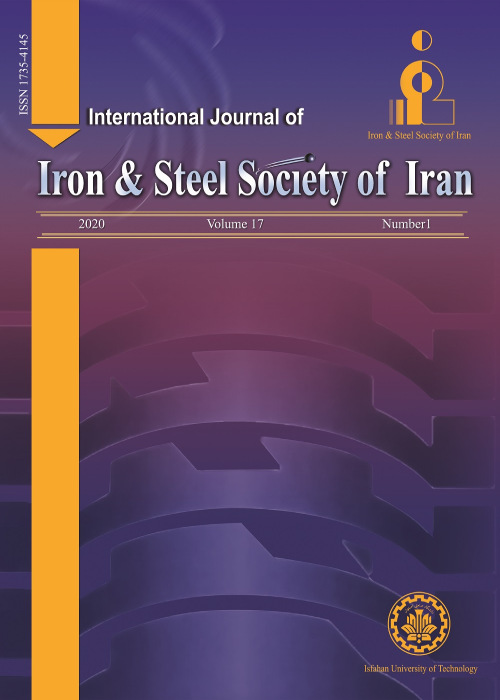فهرست مطالب
International Journal of iron and steel society of Iran
Volume:1 Issue: 1, Summer and Autumn 2004
- تاریخ انتشار: 1384/10/11
- تعداد عناوین: 7
-
-
Page 1Processing map for hot working of Ti-IF steel has been developed in the temperature range of 750 to 1100 °C and strain rate of 0.01 to 100 s-1. This map in the austenite region exhibits a single domain with a peak efficiency of 45% occurring at 1025 °C and strain rate of 0.02 s-1. The domain extends over the temperature range of 1000 to 1100 °C and strain rate range of 0.01 to 1 s-1. The true stress-strain curves and microstructural observations shows the occurrence of dynamic recrystallization in this domain. In two phase regions, where austenite and ferrite are present together, flow localization occurs in the form of bands with a fine grained structure as a result of dynamic recrystallization in the bands. These deformation bands are formed at 45° with respect to axial direction of compression. The processing map in ferrite region exhibits a domain with a peak efficiency of 38% occurring at 825 °C and strain rate of 0.02 s-1, so this domain extends over the temperature range of 800 to 850 °C and strain rate range of 0.01 to 0.5 s-1. The true stress-strain curves and microstructural results confirm the occurrence of partially dynamic recrystallization in this domain.
-
Page 8The influence of aluminium on the microstructure of austempered ductile cast iron (ADI) has been studied. A number of irons of different compositions have been made by green sand casting and gravity die casting of appropriate design to provide the experimental materials. Austenitising was carried out at different temperatures and holding times for a variety of experimental irons to achieve sufficient homogeneity for further isothermal heat treatment. The transformation to a bainitic microstructure during austempering under different conditions was then examined for the most successful of the experimental casts. Austenitising temperature of 920C, and austempering temperature of 350 C for 1 minute have been used. Microstructures have been examined by the light and scanning electron microscopy (SEM). The microstructure of austempered ductile cast iron (ADI) consists of nodular graphite which is randomly dispersed in a bainitic matrix consisting of bainitic ferrite and carbon enriched retained austenite. It has been shown that the former austenite grain boundaries are the preferred sites for bainite nucleation and the best sites for nucleation are grain corners.
-
Page 15With careful design, mixed microstructures consisting of fine plates of upper bainitic ferrite separated by thin films of stable retained austenite have exhibited impressive combinations of strength and toughness in highsilicon bainitic steels. The silicon suppresses the precipitation of brittle cementite leading to an improvement in toughness. The essential principles governing the optimisation of such microstructures are well established, particularly that large regions of unstable high-carbon retained austenite must be avoided. The aim of the present work was to see how far these concepts can be extended to achieve the highest ever combination of strength and toughness in bulk-samples, consistent with certain hardenability and processing requirements.
-
Page 24Production of Fe-C alloy powders by mechanical alloying was studied. Fe and graphite elemental powder mixtures containing 0.8 and 1.5wt.% graphite were mechanically alloyed using a planetary ball mill. The structural changes of powder particles during mechanical alloying were studied by x-ray diffractometery, scanning electron microscopy and microhardness measurements. For both compositions, mechanical alloying for 30h resulted in the development of a nanocrystalline structure with a typical grain size of 16nm containing nanoscale size Fe3C phase. This structure exhibited high microhardness value of the order of 600Hv. The powder particles after 30h of milling had a nearly spherical morphology and narrow size distribution. The mean powder particle size for Fe-0.8wt.% graphite composition was 15μm, whereas the Fe-1.5wt.% graphite composition achieved a smaller particle size with a mean of 9μm due to higher graphite content.
-
Page 29In this research a layer of Ni-Cu-P was deposited on 304 stainless steels by using gelatin and thiourea as additives in a sulfate solution. In order to determine the properties of deposited layers, a microhardness tester was used for microhardness measurement, X.R.D. for microstructural analysis, and a scanning electron microscope equipped with E.D.X. for determining morphology and analyzing the deposits. The results of the experiment show that in the presence of additives in solution, deposited layers are rough, and elements such as Fe,O2 and S enter into the layer, in the presence of thiourea and in the presence of gelatin Fe enters into the layer. The microhardness of alloyed layer without using additives is higher than the microhardness of the layer obtained in the solution containing gelatin and less than that containing thiourea. After heat treatment, the microhardness of layers increases, the reason is the formation of stable Ni3P phase in structure.
-
Page 35onsumption in the hot rolling mills. In this work the application and optimizing of hot charging of continuously cast slab in Mobareke Steel Company has been investigated. Mathematical relationship between the cooling time of the stack of slabs and its mass average temperature is described. The results show that the application of the hot charging of slabs could reduce the energy consumption by 40%.
-
Page 38Application of hyperactivation process in palletizing iron ore, in order to decrease bentonite consumption has been investigated. Different amounts of bentonite and sodium hydroxide, as activating agents,were added to iron ore and the quality of formed pellets were determined. The results show that addition of 0.01 ct. NaOH improves the pellet quality significantly while the bentonite content remains constant at 0.7 pct. oreover, pellet quality parameters were maintained within desired limit values while 0.02 ct NaOH and 0.4 ct bentonite were used. NaOH changes the chemistry of calcium-bentonite to sodium-bentonite that dispatches ore easily in iron ore matrix. Homogeneous dispersion of bentonite in hyperactive mixtures creates uniform hysical bonds between iron ore particles within pellet and results in less bentonite consumption.


